Irish Perspectives on School Ambient Air Quality: A Design-Led Exploration
Abstract
:1. Introduction
1.1. Air Quality Awareness
1.2. Air Quality and Environmental Justice
1.3. Self-Regulated Behavioral Change Model
1.4. Design Thinking Approach
- Understand: Collect perspectives on ambient air quality and initiatives along with secondary research, including analyses of comparable projects, to formulate the design challenge.
- Observe: Ethnographic interviews with parents/carers, school staff and key stakeholders to understand the context of the problem. Correlate human patterns, emotions and needs and distill them into ‘insights’.
- Point of View: Synthesize key insights to inform evidence-based archetypal ‘personas’ (artefacts).
- Ideate: Personas developed underpin evidence-based recommendations formulated using design principles submitted to Cork City Council regarding school ambient air quality.
- To collect parent/guardian and school staff awareness and perspectives on air quality around schools, air quality sensors and possible initiatives to improve air quality outside schools.
- To formulate design-led artefacts and evidence-based recommendations regarding air quality outside schools.
2. Materials and Methods
2.1. Design
2.2. Survey Sample
2.3. Interviewee Sample
2.4. Materials
2.5. Data Analysis
2.6. Ethics
2.7. Limitations
3. Results
3.1. Perspectives on Air Quality
‘Air quality is a concern as we need to ensure we are doing the best for our children’s health in the long-term as well as short-term and with lots more traffic and more exposure to fumes around schools, the health impact is what is particularly concerning. Respiratory issues first and foremost…people aren’t aware how much smell and poor air quality impacts and for well-being too’ (parent 3). Another interviewee noted though about air quality: it’s not something that would be on WhatsApp groups or something like that, and it’s not something I’ve ever seen come up as a topic of discussion’ (parent 1).
3.2. Pollutant Awareness
3.3. Air Quality Sensors
3.4. Car Idling
3.5. Transport-Related Initiatives
3.6. Awareness-Building Initiatives
3.7. Tailored Policy Initiatives
‘And you know that idea of common but differentiated responsibility in terms of response to climate change is that those people living in socio economically deprived communities have less room to pivot or less room to adapt. It may feel to somebody who’s living on a pension that it’s cheaper for them to heat one room by means of an open fire. You won’t get a community development worker to go out to a deprived community and say, OK, now you have to be climate champions’. (expert 1).
4. Discussion
4.1. Perspectives on Air Quality and Pollutant Awareness
4.2. Air Quality Monitoring
4.3. Air Quality Initiatives
4.4. Co-Design Workshops
4.4.1. Evidence-Based Artefacts
4.4.2. Insight Cards
4.4.3. Storyboards
4.4.4. Evidence-Based Personas
5. Conclusions and Recommendations
Author Contributions
Funding
Institutional Review Board Statement
Informed Consent Statement
Data Availability Statement
Acknowledgments
Conflicts of Interest
Abbreviations
| PM2.5 | Particulate matter |
| NO2 | Nitrogen dioxide |
| UN | United Nations |
| EPA | Environmental Protection Agency |
| WHO | World Health Organisation |
References
- United Nations. Sustainable Development Goals Report 2023. Available online: https://desapublications.un.org/publications/sustainable-development-goals-report-2023-special-edition (accessed on 25 March 2025).
- Government of Ireland. National Planning Framework. 2018. Available online: https://www.npf.ie/wp-content/uploads/Project-Ireland-2040-NPF.pdf (accessed on 18 March 2025).
- Environmental Protection Agency (EPA). Annual Air Quality Report 2023. Available online: https://www.epa.ie/publications/monitoring--assessment/air/air-quality-in-ireland-2023.php (accessed on 16 December 2024).
- European Commission. Revised Ambient Air Quality Directive 2024. Available online: https://environment.ec.europa.eu/news/new-pollution-rules-come-effect-cleaner-air-2030-2024-12-10_en (accessed on 25 February 2025).
- O’Sullivan, P.D.; Theofanis Psomas, T.; Devarapu, G.C.R.; O’ Donovan, A.C. Assessing Suburban Air Quality Constraints on Free Cooling in an Irish City. arXiv 2025, arXiv:2505.04746. Available online: http://arxiv.org/abs/2505.04746 (accessed on 8 May 2025).
- World Health Organization (WHO). Global Air Quality Guidelines. 2021. Available online: https://iris.who.int/bitstream/handle/10665/345329/9789240034228-eng.pdf (accessed on 28 March 2025).
- Environmental Protection Agency. Air. Available online: https://www.epa.ie/our-services/monitoring--assessment/air/ (accessed on 9 December 2024).
- Environmental Protection Agency. Air Quality Index for Health. Available online: https://airquality.ie/information/air-quality-index-for-health (accessed on 4 December 2024).
- Bowatte, G.; Lodge, C.J.; Knibbs, L.D.; Erbas, B.; Perret, J.L.; Jalaludin, B.; Morgan, G.G.; Bui, D.S.; Giles, G.G.; Hamilton, G.S.; et al. Traffic related air pollution and development and persistence of asthma and low lung function. Environ. Int. 2018, 113, 170–176. [Google Scholar] [CrossRef] [PubMed]
- Calderón-Garcidueñas, L.; Leray, E.; Heydarpour, P.; Torres-Jardón, R.; Reis, J. Air pollution, a rising environmental risk factor for cognition, neuro inflammation and neurodegeneration: The clinical impact on children and beyond. Rev. Neurol. 2016, 172, 69–80. [Google Scholar] [CrossRef]
- Flores-Pajot, M.-C.; Ofner, M.; Do, M.T.; Lavigne, E.; Villeneuve, P.J. Childhood autism spectrum disorders and exposure to nitrogen dioxide, and particulate air pollution: A review and meta-analysis. Environ. Res. 2016, 151, 763–776. [Google Scholar] [CrossRef] [PubMed]
- Landrigan, P.J.; Fuller, R.; Acosta, N.J.R.; Adeyi, O.; Arnold, R.; Basu, N.; Baldé, A.B.; Bertollini, R.; Bose-O’Reilly, S.; Boufford, J.I.; et al. The Lancet Commission on pollution and health. Lancet 2017, 391, 462–512. [Google Scholar] [CrossRef]
- Lyons, S.; Nolan, A.; Carthy, P.; Griffin, M.; O’Connell, B. Long-term exposure to PM2.5 air pollution and mental health: A retrospective cohort study in Ireland. BMC Environ. Health 2024, 23, 54. [Google Scholar] [CrossRef]
- Newbury, J.B.; Stewart, R.; Fisher, H.L.; Beevers, S.; Dajnak, D.; Broadbent, M.; Pritchard, M.; Shiode, N.; Heslin, M.; Hammoud, R.; et al. Association between air pollution exposure and mental health service use among individuals with first presentations of psychotic and mood disorders: Retrospective cohort study. Br. J. Psychiatry 2021, 219, 678–685. [Google Scholar] [CrossRef]
- Porta, D.; Narduzzi, S.; Badaloni, C.; Bucci, S.; Cesaroni, G.; Colelli, V.; Davoli, M.; Sunyer, J.; Zirro, E.; Schwartz, J.; et al. Air Pollution and Cognitive Development at Age 7 in a Prospective Italian Birth Cohort. Epidemiology 2016, 27, 228–236. Available online: https://www.jstor.org/stable/26511831 (accessed on 13 March 2025). [CrossRef]
- Saenen, N.D.; Provost, E.B.; Viaene, M.K.; Vanpoucke, C.; Lefebvre, W.; Vrijens, K.; Roels, H.A.; Nawrot, T.S. Recent versus chronic exposure to particulate matter air pollution in association with neurobehavioral performance in a panel study of primary school children. Environ. Int. 2016, 95, 112–119. [Google Scholar] [CrossRef]
- Moschetti, A.; Giangreco, M.; Ronfani, L.; Cervellera, S.; Ruffilli, M.P.; Nume, C.; Barbi, E.; Servidio, A.G. An ecological study shows increased prevalence of autism spectrum disorder in children living in a heavily polluted area. Sci. Rep. 2024, 14, 17159. [Google Scholar] [CrossRef]
- Byrne, C.P.; Bennett, K.E.; Hickey, A.; Kavanagh, P.; Broderick, B.; O’Mahony, M.; Williams, D.J. Short-term air pollution as a risk for stroke admission: A time-series analysis. Cerebrovasc. Dis. 2020, 49, 404–411. [Google Scholar] [CrossRef] [PubMed]
- Environmental Protection Authority (EPA). Air Quality in Ireland Report 2023. Available online: https://www.epa.ie/publications/monitoring--assessment/air/air-quality-in-ireland-2023.php#:~:text=Summary%3A%20Air%20quality%20in%20Ireland,based%20WHO%20guidelines%20in%202023 (accessed on 10 December 2024).
- Chen, J.; Mölter, A.; Gómez-Barrón, J.P.; O’Connor, D.; Pilla, F. Evaluating background and local contributions and identifying traffic-related pollutant hotspots: Insights from Google Air View mobile monitoring in Dublin, Ireland. Environ. Sci. Pollut. Res. 2024, 31, 56114–56129. [Google Scholar] [CrossRef]
- Committee on the Medical Effects of Air Pollutants. Statement on the Differential Toxicity of Particulate Matter According to Source or Constituents; COMEAP, U.K. Department of Health: London, UK, 2022. Available online: https://www.gov.uk/government/publications/particulate-air-pollution-health-effects-of-exposure/statement-on-the-differential-toxicity-of-particulate-matter-according-to-source-or-constituents-2022#:~:text=The%20COMEAP%20statement%20on%20the,potency%20in%20causing%20health%20effects (accessed on 30 October 2024).
- Aithal, S.S.; Sachdeva, I.; Kurmi, O.P. Air quality and respiratory health in children. Breathe (Sheff) 2023, 19, 230040. [Google Scholar] [CrossRef] [PubMed] [PubMed Central]
- Osborne, S.; Uche, O.; Mitsakou, C.; Exley, K.; Dimitroulopoulou, S. Air quality around schools: Part I—A comprehensive literature review across high-income countries. Environ. Res. 2021, 196, 110817. [Google Scholar] [CrossRef] [PubMed]
- European Environment Agency. Air Pollution and Children’s Health. 2023. Available online: https://www.eea.europa.eu/publications/air-pollution-and-childrens-health (accessed on 9 December 2024).
- Lindén, J.; Azzouz, M.; Stockfelt, L.; Gustafsson, M.; Molnar, P.; Laurelin, M.; Rieck Jildén, J.; Olofson, H.; Watne, A.K. Location, location, location–A study of factors affecting air quality in Swedish preschool yards. Sustain. Cities Soc. 2024, 113, 105683. [Google Scholar] [CrossRef]
- Maione, M.; Mocca, E.; Eisfeld, K.; Kazepov, Y.; Fuzzi, S. Public perception of air pollution sources across Europe. Ambio 2021, 50, 1150–1158. [Google Scholar] [CrossRef]
- Central Statistics Office. Press Statement Household Environmental Behaviours—Environmental Concerns Quarter 3 2021. Available online: https://www.cso.ie/en/csolatestnews/pressreleases/2021pressreleases/pressstatementhouseholdenvironmentalbehaviours-environmentalconcernsquarter32021/ (accessed on 8 January 2025).
- Quintyne, K.I.; Kelly, C. Knowledge, attitudes, and perception of air pollution in Ireland. Public Health Pract. 2023, 29, 100406. [Google Scholar] [CrossRef] [PubMed] [PubMed Central]
- Gifford, R. The Dragons of Inaction: Psychological Barriers That Limit Climate Change Mitigation and Adaptation. Am. Psychol. 2011, 66, 290–302. [Google Scholar] [CrossRef]
- Kollmuss, A.; Agyeman, J. Mind the Gap: Why do people act environmentally and what are the barriers to pro-environmental behavior? Environ. Educ. Res. 2002, 8, 239–260. [Google Scholar] [CrossRef]
- Dioba, A.; Kroker, V.; Dewitte, S.; Lange, F. Barriers to Pro-Environmental Behavior Change: A Review of Qualitative Research. Sustainability 2024, 16, 8776. [Google Scholar] [CrossRef]
- Tversky, A.; Kahneman, D. The framing of decisions and the psychology of choice. Science 1981, 211, 453–458. [Google Scholar] [CrossRef] [PubMed]
- Kahneman, D. Thinking, Fast and Slow, 1st ed.; Farrar, Straus and Giroux: New York, NY, USA, 2011. [Google Scholar]
- Liberman, N.; Trope, Y.; Stephan, E. Psychological distance. In Social Psychology: Handbook of Basic Principles, 2nd ed.; Kruglanski, A.W., Higgins, E.T., Eds.; The Guilford Press: New York, NY, USA, 2007; pp. 353–381. [Google Scholar]
- European Commission. The Aarhus Convention and the EU. 1998. Available online: https://environment.ec.europa.eu/law-and-governance/aarhus_en (accessed on 28 April 2025).
- Johnson, B.; Duffin, M.; Murphy, M. Quantifying a relationship between place-based learning and environmental quality. Environ. Educ. Res. 2012, 18, 609–624. [Google Scholar] [CrossRef]
- Rong, T.; Ristevski, E.; Carroll, M. Exploring community engagement in place-based approaches in areas of poor health and disadvantage: A scoping review. Health Place 2023, 81, 103026. [Google Scholar] [CrossRef] [PubMed]
- Faries, M.D. Why We Don’t “Just Do It”: Understanding the Intention-Behavior Gap in Lifestyle Medicine. Am. J. Lifestyle Ed. 2016, 10, 322–329. [Google Scholar] [CrossRef] [PubMed] [PubMed Central]
- O’Neill, S.; Gleeson, C.; Torney, D.; Mercier, S.; Daly, C.; Wall, R.; Dublin DCU. Environmental Justice in Ireland: Key Dimensions of Environmental and Climate Injustice Experienced by Vulnerable and Marginalized Communities. 2022. Available online: https://communitylawandmediation.ie/wp-content/uploads/2022/03/Environmental-Justice-in-Ireland-230322-1.pdf (accessed on 27 April 2025).
- European Environment Agency. 2018 Unequal Exposure and Unequal Impacts: Social Vulnerability to Air Pollution, Noise and Extreme Temperatures in Europe. 2018. Available online: https://www.eea.europa.eu/publications/unequal-exposure-and-unequal-impacts. (accessed on 10 April 2025).
- Tubridy, F.; Mölter, A.; Lennon, M.; Pilla, F. Citizen science and environmental justice: Exploring contradictory outcomes through a case study of air quality monitoring in Dublin. Local Environ. 2022, 27, 622–638. [Google Scholar] [CrossRef]
- Hoy, A.; Mohan, G.; Nolan, A. An investigation of inequalities in exposure to PM2.5 air pollution across small areas in Ireland. Int. J. Health Geogr. 2024, 23, 17. [Google Scholar] [CrossRef]
- Fecht, D.; Fischer, P.; Fortunato, L.; Hoek, G.; De Hoogh, K.; Marra, M.; Kruize, H.; Vienneau, D.; Beelen, R.; Hansell, A. Associations between air pollution and socioeconomic characteristics, ethnicity and age profile of neighbourhoods in England and the Netherlands. Environ. Pollut. 2015, 198, 201–210. [Google Scholar] [CrossRef]
- Ball, K. Traversing myths and mountains: Addressing socioeconomic inequities in the promotion of nutrition and physical activity behaviors. Int. J. Behav. Nutr. Phys. Act. 2015, 12, 142. [Google Scholar] [CrossRef]
- Government of Ireland. Sláintecare Healthy Communities (SHC). 2021. Available online: https://www.localgov.ie/national-programmes/slaintecare-healthy-communities (accessed on 12 February 2025).
- Kretzmann, J.P.; McKnight, J.L.; McKnight, J. Building Communities from the Inside Out, 1st ed.; ACTA Publications: Evanston, IL, USA, 1993. [Google Scholar]
- Lipman, T.H.; Lobo, M.L. Special Issue on Social Determinants of Health. J. Pediatr. Nurs. 2017, 37, 1–2. [Google Scholar] [CrossRef]
- Sederer, L.I. The Social Determinants of Mental Health. Psychiatr. Serv. 2016, 67, 234–235. [Google Scholar] [CrossRef]
- Karakor, E.K. Place-Making Approachment to Accomplish Social Sustainability. Eur. J. Sustain. Dev. 2014, 3, 253–262. [Google Scholar] [CrossRef]
- Prochaska, J.O.; DiClemente, C.C. Transtheoretical therapy: Toward a more integrative model of change. Psychother. Theory Res. Pract. 1982, 19, 276–288. [Google Scholar] [CrossRef]
- Bamberg, S. Changing environmentally harmful behaviors: A stage model of self-regulated behavioral change. J. Environ. Psychol. 2013, 34, 151–159. [Google Scholar] [CrossRef]
- Cibin, R.; Venables, D.; Cassarino, M. Promoting Urban Air Quality Resilience Through Communication: A Stakeholder Needs Mapping and Prioritization Study Informed by Design Thinking. Available online: https://ssrn.com/abstract=5055465 (accessed on 28 March 2025).
- Schulders, M. Co-Creating Smart Cities—Design Thinking for 21st Century Urban Planning. Eur. Res. Stud. J. 2022, XXV, 301–315. [Google Scholar] [CrossRef]
- Nghiem, M. Reducing air pollution in cities: Evaluate the gap in population engagement and policy strategies DS 117. In Proceedings of the 24th International Conference on Engineering and Product Design Education (E&PDE 2022), London, UK, 8–9 September 2022. [Google Scholar] [CrossRef]
- Golumbic, Y.N.; Fishbain, B.; Baram-Tsabari, A. User centered design of a citizen science air-quality monitoring project. Int. J. Sci. Educ. Part B 2019, 9, 195–213. [Google Scholar] [CrossRef]
- Robinson, J.A.; Novak, R.; Kanduč, T.; Maggos, T.; Pardali, D.; Stamatelopoulou, A.; Saraga, D.; Vienneau, D.; Flückiger, B.; Mikeš, O.; et al. User-Centred Design of a Final Results Report for Participants in Multi-Sensor Personal Air Pollution Exposure Monitoring Campaigns. Int. J. Environ. Res. Public Health 2021, 18, 12544. [Google Scholar] [CrossRef]
- Kim, S.; Paulos, E. InAir: Sharing indoor air quality measurements and visualizations. In Proceedings of the CHI ’10: CHI Conference on Human Factors in Computing Systems, Atlanta, GA, USA, 10–15 April 2010; pp. 1861–1870. [Google Scholar]
- Herawati, N.A.; Surendro, K.; Hikmawati, E. Development of an Intelligent Carbon Emission Monitoring Methodology to Support Carbon Trading with A Design Thinking Approach: A Case Study in PT Paiton Energy. In Proceedings of the 10th International Conference on ICT for Smart Society (ICISS), Bandung, Indonesia, 6–7 September 2023; pp. 1–6. [Google Scholar] [CrossRef]
- Clark, R.M.; Stabryla, L.M.; Gilbertson, L.M. Sustainability coursework: Student perspectives and reflections on design thinking. Int. J. Sustain. High. Educ. 2020, 21, 593–611. [Google Scholar] [CrossRef]
- Government of Ireland. Designing our Public Service—Design Principles for Government in Ireland. 2022. Available online: https://accessible-eu-centre.ec.europa.eu/designing-our-public-services-design-principles-government-ireland_en (accessed on 25 March 2025).
- Lor, R. Design thinking in education: A critical review of literature. In Proceedings of the Asian Conference on Education & Psychology, Bangkok, Thailand, 24–26 May 2017; Available online: http://hdl.handle.net/11189/7810 (accessed on 10 February 2025).
- Devitt, F.; Ryan, M.; Vaugh, T. ARRIVE. A Design Innovation Framework to Deliver Breakthrough Services, Products and Experiences, 1st ed.; Routledge: London, UK, 2021. [Google Scholar] [CrossRef]
- Lewrick, M.; Link, P.; Leifer, L. The Design Thinking Toolbox: A Guide to Mastering the Most Popular and Valuable Innovation Methods; Wiley and Sons: Montreal, QC, Canada, 2020. [Google Scholar]
- Plattner, H.; Meinel, C.; Weinberg, U. Design Thinking. Learning Innovation—Opening Up Worlds of Ideas; mi-Wirtschaftsbuch: München, Germany, 2009; pp. 59–127. [Google Scholar]
- Hasso Plattner Institute. Design Thinking. Available online: https://hpi.de/en/d-school/topics/design-thinking/ (accessed on 20 March 2025).
- Braun, V.; Clarke, V. Thematic analysis. In Encyclopedia of Critical Psychology, 1st ed.; Teo, T., Ed.; Springer: New York, NY, USA, 2014; pp. 1947–1982. [Google Scholar]
- Dixon-Woods, M. Using framework-based synthesis for conducting reviews of qualitative studies. BMC Med. 2011, 9, 39. [Google Scholar] [CrossRef]
- Cassarino, M.; Murphy, L.; Venables, D.; Hellebust, S. Air Quality Around Schools—An Investigation of the Views of Parents/Caregivers and School Staff in Two Primary Schools in Cork. Report of Main Findings. 2022. Available online: https://osf.io/y6t2x/files/osfstorage/66fec28a75b264bd73a20330 (accessed on 12 November 2024).
- Gorman, G.; Hellebust, S.; Venables, D.; Ryan, K.; Cassarino, M. Introducing forecast-based public health warnings to promote engagement with air quality risk: A survey of citizens’ attitudes in Cork, Ireland. J. Risk Res. 2023, 26, 594–609. [Google Scholar] [CrossRef]
- GLOBE Ireland. Available online: https://www.globe.gov/web/ireland/home/about (accessed on 12 November 2024).
- Riley, R.; de Preux, L.; Capella, P.; Mejia, C.; Kajikawa, Y.; de Nazelle, A. How do we effectively communicate air pollution to change public attitudes and behaviours? A review. Sustain. Sci. 2021, 16, 2027–2047. [Google Scholar] [CrossRef]
- Knowles, E.S.; Riner, D.D. Omega approaches to persuasion: Overcoming resistance. In The Science of Social Influence: Advances and Future Progress, 1st ed.; Pratkanis, A.R., Ed.; Psychology Press: New York, NY, USA, 2007; pp. 83–114. [Google Scholar]
- Wheeler, B.W.; Ben-Shlomo, Y.B.S. Environmental equity, air quality, socioeconomic status, and respiratory health: A linkage analysis of routine data from the Health Survey for England. J. Epidemiol. Community Health 2005, 59, 948–954. [Google Scholar] [CrossRef] [PubMed]
- Delmas, M.A.; Kohli, A. Can apps make air pollution visible? learning about health impacts through engagement with air quality information. J. Bus. Ethics 2020, 161, 279–302. [Google Scholar] [CrossRef]
- National Transport Authority. Safe Routes to School. 2020. Available online: www.nationaltransport.ie/planning-and-investment/transport-investment/active-travel-investment-programme/safe-routes-to-school-srts-programme-active-travel/ (accessed on 9 December 2024).
- Schulte, K. Real-time’ air quality channels: A technology review of emerging environmental alert systems. Big Data Soc. 2022, 9, 1. [Google Scholar] [CrossRef]
- McCarron, A.; Semple, S.; Braban, C.F.; Swanson, V.; Gillespie, C.; Price, H.D. Public engagement with air quality data: Using health behaviour change theory to support exposure-minimizing behaviors. J. Expo. Sci. Env. Epidemiol. 2023, 33, 321–331. [Google Scholar] [CrossRef] [PubMed] [PubMed Central]
- LeRouge, C.; Ma, J.; Sneha, S.; Tolle, K. User profiles and personas in the design and development of consumer health technologies. Int. J. Med. Inform. 2013, 82, e251–e268. [Google Scholar] [CrossRef]
- Morgan, T. Sensing Our World: How Digital Cultural Practices Can Contribute to Changing Social Norms Around Consumption; Environmental Protection Agency: Dublin, Ireland, 2020; Available online: www.epa.ie/publications/research/socio-economics/Research_Report_355.pdf (accessed on 1 May 2025).
- Brereton, P. Environmental Literacy and New Digital Audiences, 1st ed.; Routledge: London, UK, 2018. [Google Scholar] [CrossRef]
- Brereton, P. Essential Concepts of Environmental Communication: An A–Z Guide, 1st ed.; Routledge: London, UK, 2022. [Google Scholar] [CrossRef]
- Nouri, S.S.; Avila-Garcia, P.; Cemballi, A.G.; Sarkar, U.; Aguilera, A.; Lyles, C.R. Assessing Mobile Phone Digital Literacy and Engagement in User-Centered Design in a Diverse, Safety-Net Population: Mixed Methods Study. JMIR MHealth UHealth 2019, 7, e14250. [Google Scholar] [CrossRef]
- Estacio, E.V.; Whittle, R.; Protheroe, J. The digital divide: Examining socio-demographic factors associated with health literacy, access and use of internet to seek health information. J. Health Psychol. 2017, 24, 1668–1675. [Google Scholar] [CrossRef] [PubMed]
- Estrela, M.; Semedo, G.; Roque, F.; Lopes Ferreira, P.; Herdeiro, M.T. Sociodemographic determinants of digital health literacy: A systematic review and meta-analysis. Int. J. Med. Inform. 2023, 177, 105124. [Google Scholar] [CrossRef]
- Azzopardi-Muscat, N.; Sørensen, K. Towards an equitable digital public health era: Promoting equity through a health literacy perspective. Eur. J. Public Health. 2019, 29 (Suppl. S3), 13–17. [Google Scholar] [CrossRef] [PubMed] [PubMed Central]
- Workman, A.; Jones, P.J.; Wheeler, A.J.; Campbell, S.L.; Williamson, G.J.; Lucani, C.; Bowman, D.M.J.S.; Cooling, N.; Johnston, F.H. Environmental Hazards and Behavior Change: User Perspectives on the Usability and Effectiveness of the AirRater Smartphone App. Int. J. Environ. Res. Public Health 2021, 18, 3591. [Google Scholar] [CrossRef] [PubMed] [PubMed Central]
- Samet, J.M. Community Design and Air Quality. In Making Healthy Places, 1st ed.; Dannenberg, A.L., Frumkin, H., Jackson, R.J., Eds.; Island Press: Washington, DC, USA, 2011. [Google Scholar] [CrossRef]
- Conway, R.; Masters, J.; Thorold, J. From Design Thinking to Systems Change How to Invest in Innovation for Social Impact. 2017. Available online: https://andiroberts.com/wp-content/uploads/2020/04/rsa_from-design-thinking-to-system-change-report.pdf (accessed on 18 November 2024).
- Rosen, Z.; Bice, C.; Scott, S. Visualizing the Invisible: Visual-Based Design and Efficacy in Air Quality Messaging. Int. J. Environ. Res. Public Health 2021, 18, 10882. [Google Scholar] [CrossRef] [PubMed] [PubMed Central]
- Ayrton, R. The case for creative, visual and multimodal methods in operationalizing concepts in research design: An examination of storyboarding trust stories. Sociol. Rev. 2020, 68, 1229–1240. [Google Scholar] [CrossRef]
- Young, R.; Sage, K.; Broom, D.; Hext, A.; Smith, C. Effective use of storyboarding as a co-design method to enhance power assisted exercise equipment for people with stroke. Des. Health 2022, 6, 244–275. [Google Scholar] [CrossRef]
- Norman, D.A.; Verganti, R. Incremental and Radical Innovation: Design Research vs. Technology and Meaning Change. Design Issues 2014, 30, 78–96. [Google Scholar] [CrossRef]

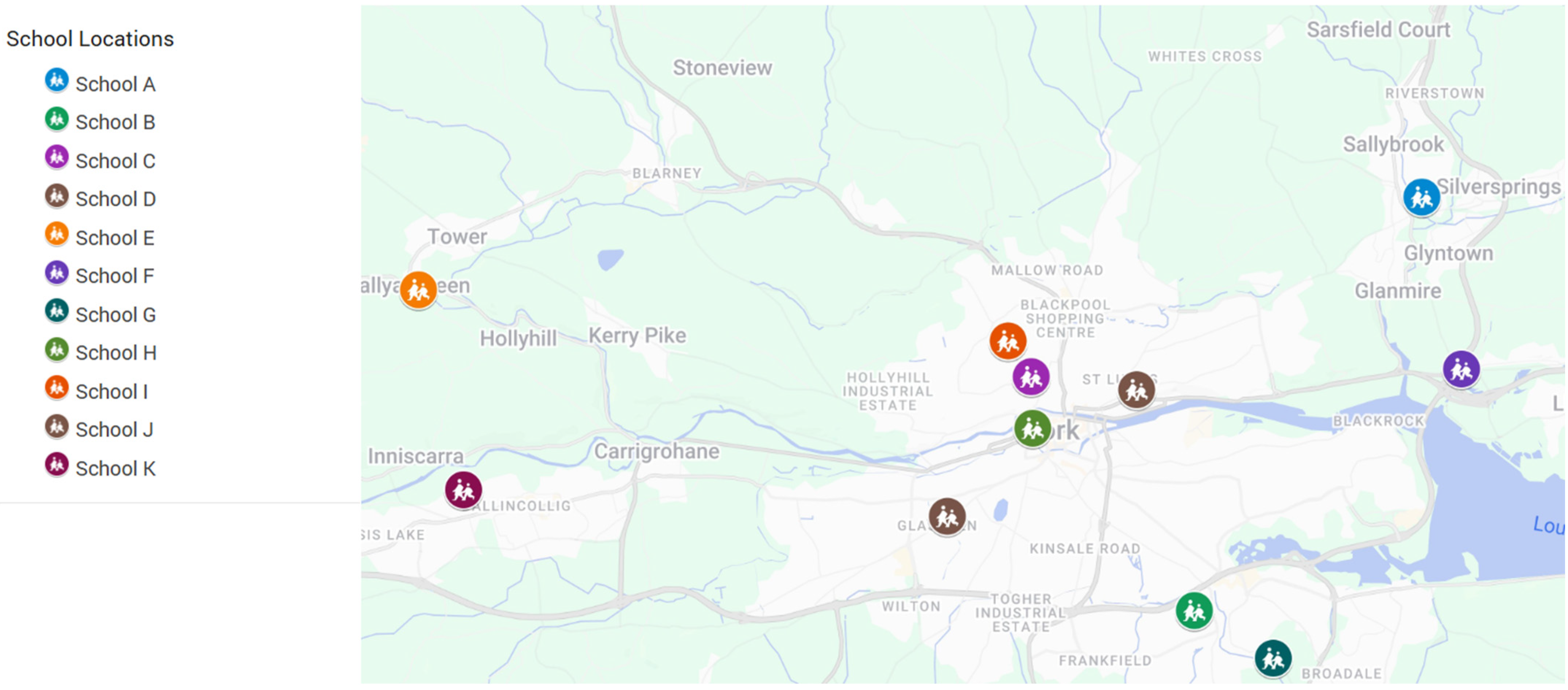

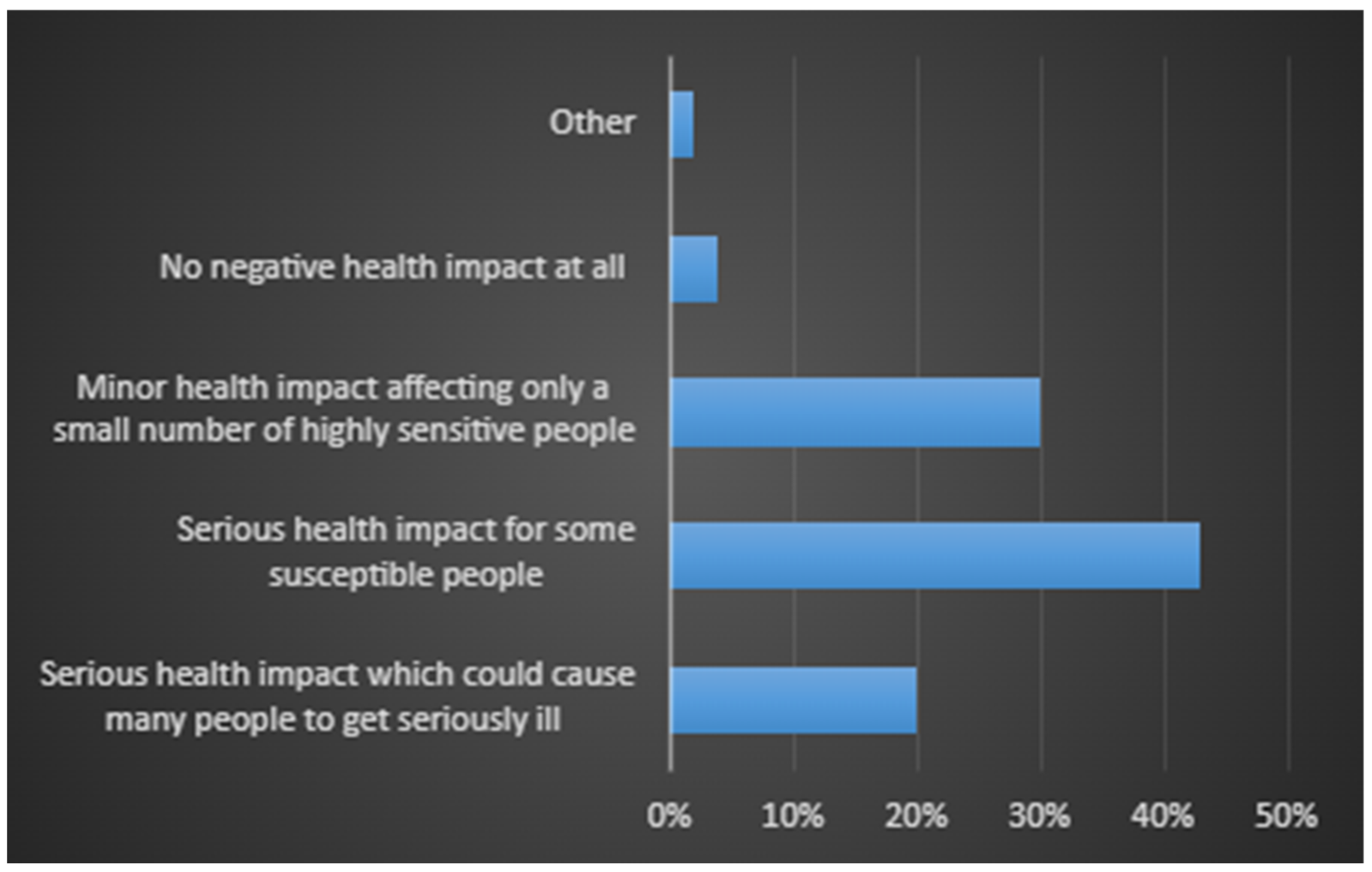
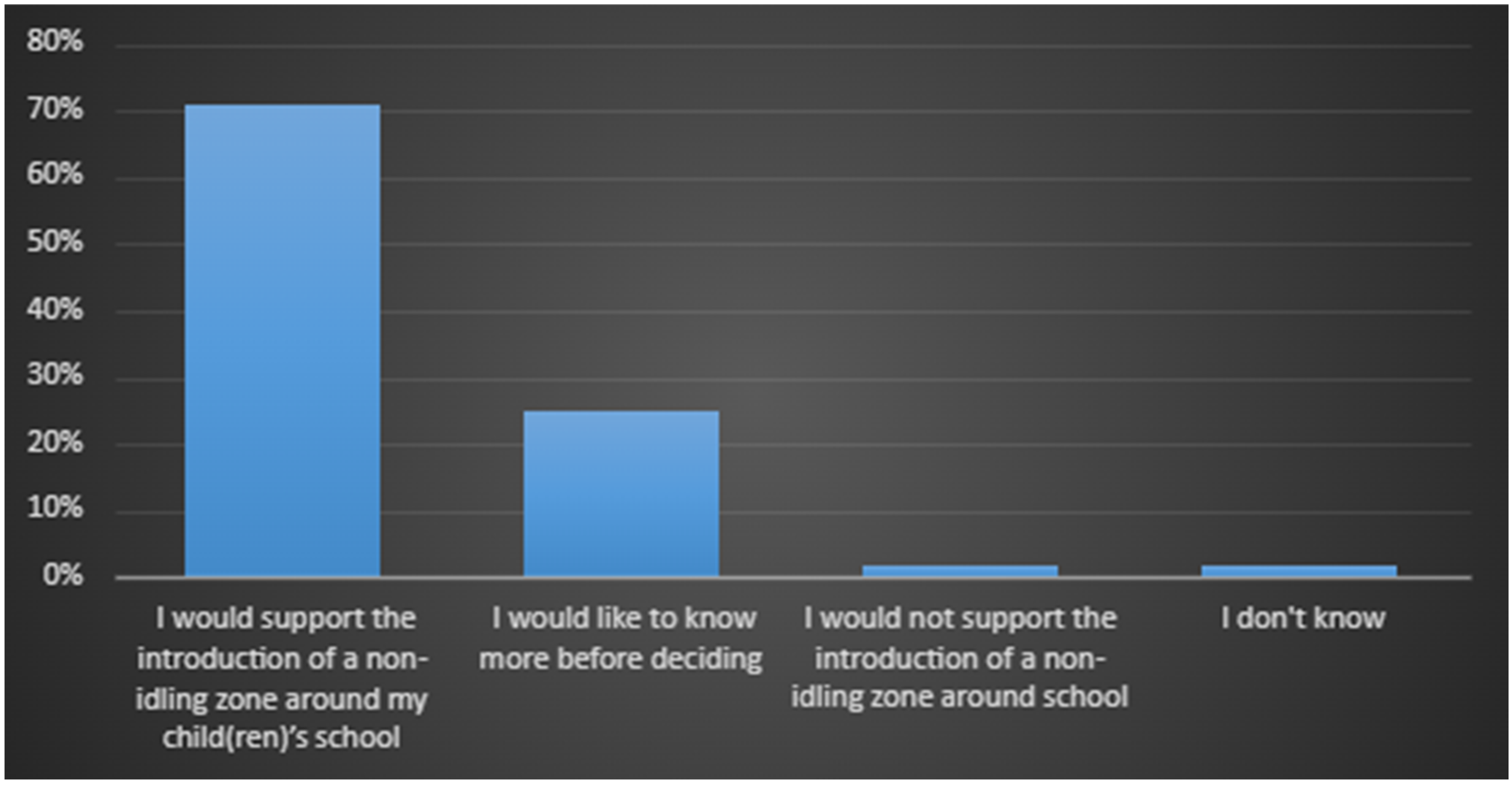
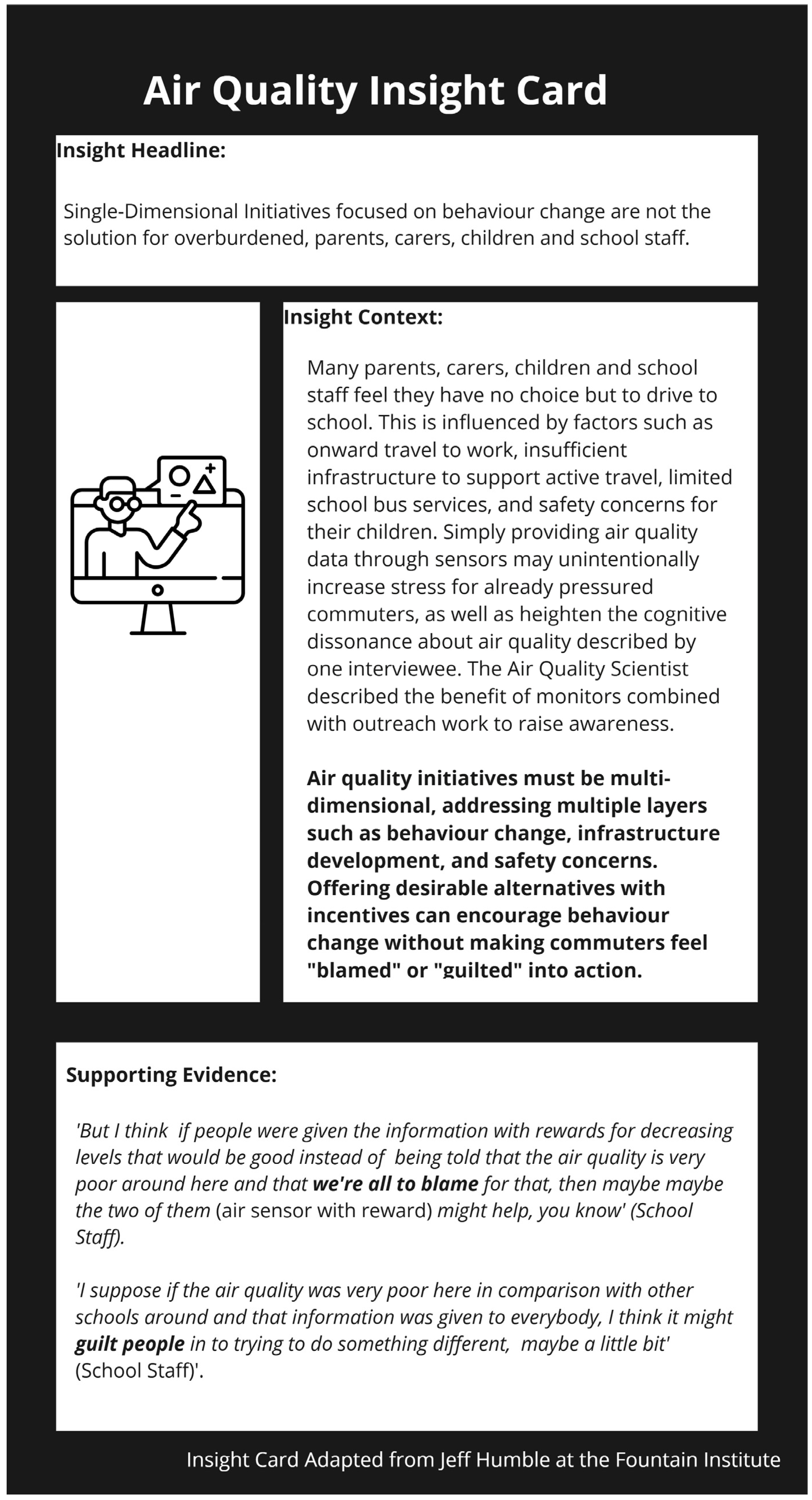
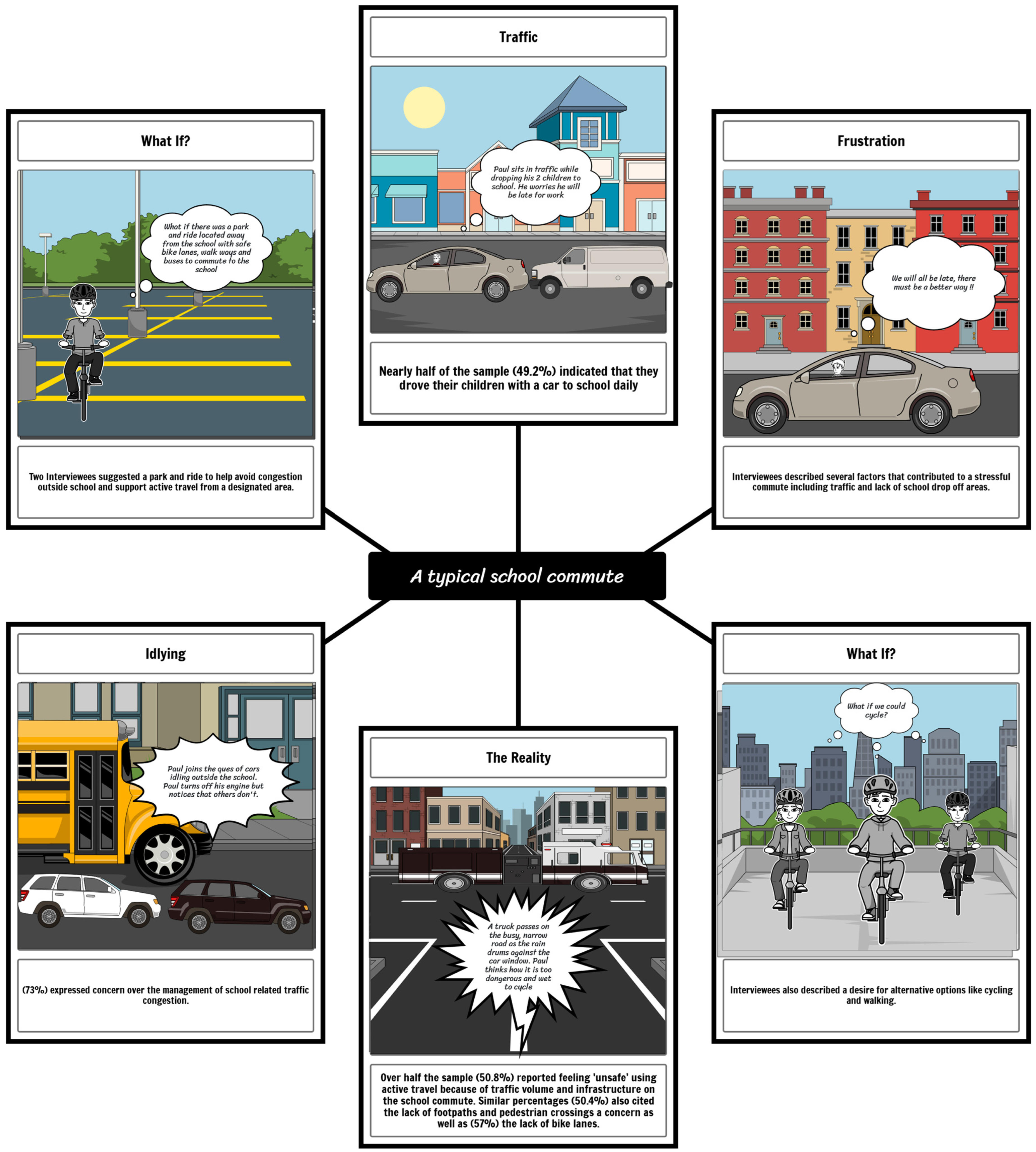

Disclaimer/Publisher’s Note: The statements, opinions and data contained in all publications are solely those of the individual author(s) and contributor(s) and not of MDPI and/or the editor(s). MDPI and/or the editor(s) disclaim responsibility for any injury to people or property resulting from any ideas, methods, instructions or products referred to in the content. |
© 2025 by the authors. Licensee MDPI, Basel, Switzerland. This article is an open access article distributed under the terms and conditions of the Creative Commons Attribution (CC BY) license (https://creativecommons.org/licenses/by/4.0/).
Share and Cite
de Róiste, Á.; Stack, A.; Devarapu, G.C.R.; O’Faolain, L.; Galvin, M. Irish Perspectives on School Ambient Air Quality: A Design-Led Exploration. Sustainability 2025, 17, 4793. https://doi.org/10.3390/su17114793
de Róiste Á, Stack A, Devarapu GCR, O’Faolain L, Galvin M. Irish Perspectives on School Ambient Air Quality: A Design-Led Exploration. Sustainability. 2025; 17(11):4793. https://doi.org/10.3390/su17114793
Chicago/Turabian Stylede Róiste, Áine, Aoife Stack, Ganga Chinna Rao Devarapu, Liam O’Faolain, and Mary Galvin. 2025. "Irish Perspectives on School Ambient Air Quality: A Design-Led Exploration" Sustainability 17, no. 11: 4793. https://doi.org/10.3390/su17114793
APA Stylede Róiste, Á., Stack, A., Devarapu, G. C. R., O’Faolain, L., & Galvin, M. (2025). Irish Perspectives on School Ambient Air Quality: A Design-Led Exploration. Sustainability, 17(11), 4793. https://doi.org/10.3390/su17114793





